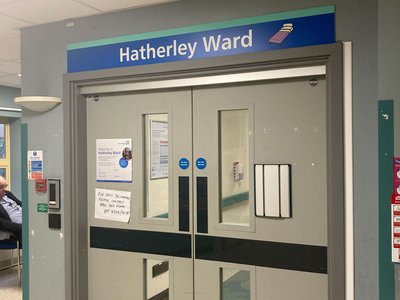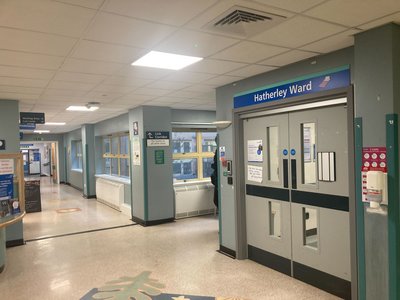New Hyper-Acute Stroke Unit opens on Hatherley Ward at Cheltenham General Hospital
The Hyper-Acute Stroke Unit (HASU) at Cheltenham General Hospital moves to a newly refurbished location named Hatherley Ward on 5 February 2025.
This significant development brings enhanced facilities and a consolidated specialist team, ensuring first-class care for stroke patients across Gloucestershire and beyond.
Stroke is a leading cause of death and disability, caused by an interruption to the brain’s blood supply or a rupture of a blood vessel. Rapid and expert intervention is critical to improving outcomes, and the HASU at Cheltenham General is designed to deliver life-saving treatment 24 hours a day.
Expert Care Under One Roof
The new HASU consolidates expertise, bringing together specialists and state-of-the-art equipment to provide first-class stroke treatment. Research shows that patients treated in dedicated stroke units experience better outcomes, including reduced mortality rates and fewer long-term disabilities, compared to care provided in general medical wards.
A typical patient journey might begin with paramedics identifying stroke symptoms and administering immediate care before transferring the patient to the HASU. Upon arrival, the patient undergoes rapid imaging and assessment by the stroke team, followed by early treatment, which may include thrombolysis or thrombectomy.
Patients typically remain in the HASU for up to 72 hours before being moved to a specialist ward, such as Woodmancote Ward at Cheltenham General Hospital or the rehabilitation ward at Vale Community Hospital.
Enhanced Facilities and Services
The new HASU offers high-dependency beds to support patients requiring urgent care. The unit is staffed by a multidisciplinary team of highly trained professionals, including consultants, doctors, specialist nurses and therapists. This ensures patients receive around-the-clock monitoring, early intervention and continuous care.
Key features of the HASU include:
- Rapid assessment: Patients are quickly assessed upon arrival to determine the most effective treatment pathway.
- Early treatment: Cutting-edge therapies such as clot-busting thrombolysis are administered where necessary and patients who require mechanical thrombectomy are referred rapidly to Southmead Hospital.
- Continuous care: High-dependency beds offer 24/7 monitoring and advanced physiological support.
Supporting Recovery Beyond the HASU
Stroke care extends beyond the hospital stay. Once stabilised, many patients transition to a specialist rehabilitation ward or receive support in their home or residence from the Stroke Early Supported Discharge Team provided by Gloucestershire Health and Care NHS Foundation Trust. This team helps patients regain independence while transitioning back home, offering tailored therapy and ongoing support.
Regional Impact
The HASU at Cheltenham General Hospital admits acute stroke patients from across Gloucestershire and neighbouring areas, ensuring residents have access to the highest standard of care. By consolidating expertise and resources, the new unit reinforces Cheltenham’s role as a regional leader in stroke treatment.
Visiting Hours and Patient Care
To support recovery, patients on HASU have a daily rest period from 1:30 pm to 3:00 pm, during which visiting is not permitted. Exceptions can be discussed with the ward manager or nurse in charge.
The new HASU on Hatherley Ward not only offers patients in Gloucestershire the best possible care following a stroke but also provides our multidisciplinary team with a centre of excellence from which we can further develop our specialist services
Dr Kate Hellier, Consultant Stroke Physician and Deputy Medical Director



Thrombolysis: Clot-Busting treatment
When a patient arrives within hours of showing stroke-like symptoms, they are quickly evaluated by a team of stroke specialists to determine if they may have had a stroke.
If a stroke is suspected, the patient is promptly taken for a CT scan to identify whether the stroke was caused by a blocked artery (an "ischaemic stroke") or a ruptured artery (a "haemorrhagic stroke"). For strokes caused by a blocked artery, a clot-dissolving medication (thrombolytic agent) is administered through a vein (intravenously). This drug circulates throughout the body, and a portion of it reaches the clot, often dissolving it. In some cases, this treatment results in immediate improvement, with stroke symptoms disappearing. Even when instant improvement isn't visible, long-term recovery outcomes are generally better with this treatment.
The sooner thrombolysis is given, the greater the benefit to the patient. To track efficiency, we record the exact arrival time of each patient (referred to as "door" time) and key milestones until the drug is administered (known as "needle" time).
Our door-to-needle times are the best in the south-west region (34 minutes*) and we continuously analyse each case to find ways to reduce these times further.
*Source: SSNAP data, July - Sept 2024
Act FAST to Save Lives
Prompt recognition of stroke symptoms is vital. Remember to Act FAST:
- Face: Is there weakness or drooping?
- Arms: Can they raise both arms?
- Speech: Is speech slurred or confused?
- Time: Call 999 immediately.